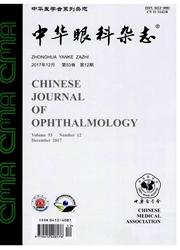

 中文摘要:
中文摘要:
背景 Hypopyon 在有临床的特征的真菌的 keratitis.The 评估的眼睛是普通的, hypopyon 并且在 hypopyon 和治疗结果之间的可能的关联的文化结果和风险因素能是有用的因为与真菌的角膜炎使治疗 decisions.Methods 成为 1066 个住院病人( 1069 只眼睛)的医药记录在山东眼睛看到到2009年12月的从2000年1月的研究所回顾地被考察为人口统计特征,风险因素,临床的 characteri
 英文摘要:
英文摘要:
Background Hypopyon is common in eyes with fungal keratitis.The evaluation of the clinical features,culture results and the risk factors for hypopyon and of the possible correlation between hypopyon and the treatment outcome could be helpful for making treatment decisions.Methods The medical records of 1066 inpatients (1069 eyes) with fungal keratitis seen at the Shandong Eye Institute from January 2000 to December 2009 were reviewed retrospectively for demographic features,risk factors,clinical characteristics,laboratory findings and treatment outcomes.The incidence of hypopyon,the fungal culture positivity for hypopyon,risk factors for hypopyon and the effect of hypopyon on the treatment and prognosis were determined.Results We identified 1069 eyes with fungal keratitis.Of the 850 fungal culture-positive eyes,the Fusarium species was the most frequent (73.6%),followed by Altemaria (10.0%) and Aspergillus (9.0%).Upon admission,562 (52.6%)eyes with hypopyon were identified.The hypopyon of 66 eyes was evaluated via fungal culturing,and 31 eyes (47.0%)were positive.A total of 194 eyes had ocular hypertension,and 172 (88.7%) of these eyes had hypopyon (P 〈0.001).Risk factors for incident hypopyon included long duration of symptoms (P 〈0.001),large lesion size (P 〈0.001) and infection caused by the Fusarium and Aspergillus species (P 〈0.001).The positivity of fungal culture for hypopyon was associated with duration of symptoms and lesion size.Surgical intervention was more common in cases with hypopyon (P 〈0.001).Hypopyon was a risk factor for the recurrence of fungal keratitis after corneal transplantation (P=0.002).Conclusions Hypopyon is common in patients with severe fungal keratitis and can cause ocular hypertension.About half of the hypopyon cases were positive based on fungal culture.Long duration of symptoms,large lesion size and infection with the Fusarium and Aspergillus species were risk factors for hypopyon.The presence of hypopyon increasesthe
 同期刊论文项目
同期刊论文项目
 同项目期刊论文
同项目期刊论文
 Risk Factors, Clinical Features, and Outcomes of Recurrent Fungal Keratitis after Corneal Transplant
Risk Factors, Clinical Features, and Outcomes of Recurrent Fungal Keratitis after Corneal Transplant Role of extracellular phospholipase B of Candida albicans as a virulent factor in experimental kerat
Role of extracellular phospholipase B of Candida albicans as a virulent factor in experimental kerat 期刊信息
期刊信息
